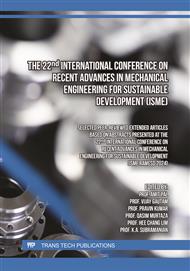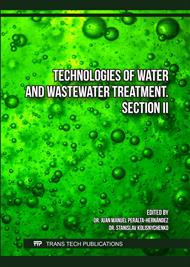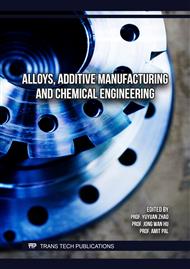[1]
H. M. Abdel-Ghafar, B. E. El Anadouli, Iron Removal from Ground Water Using Egyptian Cost-Effective Clay Minerals, Applied Chemical Engineering, 2(2019)
DOI: 10.24294/ace.v3i1.470
Google Scholar
[2]
I. Abdullahi Moyosore, S. Bello, Purification of polluted water from Jibiadam, Nigeria using powdered Moringaoleifera seeds. MAYFEB Journal of Chemistry and Chemical Engineering, 2 (2018), pp.1-4.
Google Scholar
[3]
O. Akaninyene, J.O. Akankpo, Investigation of the Physical Properties of Uruan Clay Soil Used for Manufacturing of Burnt Bricks. Advances in Physics Theories and Applications, 53 (2016), p.18–22.
Google Scholar
[4]
S. Aluvihara, C.S. Kalpage, Characterization of Sri Lankan brick clays for more advanced industrial uses, International Scientific Journal "Machines. Technologies. Materials, 14(4), 2020, pp.181-185.
Google Scholar
[5]
S. Aluvihara, C.S. Kalpage, Particle Size Analysis of Different Clay Types, International Conference of Advance Research and Innovation (ICARI-2020), 2020, pp.44-49.
Google Scholar
[6]
S. Aluvihara, C.S. Kalpage and K.L. Lemle, Elementary chemical analysis of different clay types, Journal of Physics, 1781, 2021
DOI: 10.1088/1742-6596/1781/1/012007
Google Scholar
[7]
Y. Chunguang, X. Han, Adsorbent Material Used in Water Treatment-A Review. International Workshop on Materials Engineering and Computer Sciences, 2015, pp.290-293.
Google Scholar
[8]
H.E. Fadel, M. Merzouki, M. Faouzi, A. Laamayem, M. Najem, M. Benlemlih, Purification Performance of Filtration Process for Leachate in Morocco by Marine Sands, Clays and Fly Ash. Journal of Biotechnology Letters, 4(1), 2013, p.51–59.
Google Scholar
[9]
D.O. Folorunso, P. Olubambi, J.O. Borode, Characterization and Qualitative Analysis of Some Nigerian Clay Deposits for Refractory Applications. IOSR Journal of Applied Chemistry, 7(9), 2014, pp.40-47.
DOI: 10.9790/5736-7914047
Google Scholar
[10]
J. Janet, Kipsanai, S. S. Namango, A. M. Muumbo, A Study of Selected Kenyan Anthill Clays for Production of Refractory Materials. International Journal of Scientific and Research Publications, 7(9), 2017, p.169–179.
Google Scholar
[11]
Y. John, V.E. David, D. Mmereki, A comparative study on removal of hazardous anions from water by adsorption: A review. International Journal of Chemical Engineering, 2018 (2018), pp.1-21
DOI: 10.1155/2018/3975948
Google Scholar
[12]
G.D. Manoj Pradhanand, Effect of Fragment Size, Uniformity Coefficient and Moisture Content on Compaction and Shear Strength Behavior of Coal Mine Overburden Dump Material. European Journal of Advances in Engineering and Technology, 2(12), 2015, pp.1-10.
Google Scholar
[13]
K. Murali, K. Sambath, S. Mohammed Hashir, A Review on Clay and its Engineering Significance. A Review on Clay and Its Engineering Significance, International Journal of Scientific and Research Publications, 8(2), 2018, pp.8-11.
Google Scholar
[14]
C.C. Nnaji, B.C. Afangideh, C. Ezeh, Performance evaluation of clay-sawdust composite filter for point of use water treatment. Nigerian Journal of Technology, 35(4), 2016, p.949
DOI: 10.4314/njt.v35i4.33
Google Scholar
[15]
E.S. Nweke, E.I. Ugwu, Analysis and Characterization of Clay Soil in Abakaliki, Nigeria. The Pacific Journal of Science and Technology, 8(2), 2007, p.190–193.
Google Scholar
[16]
C.I.R. de Oliveira, M.C.G. Rocha, A.L.N. da Silva, L.C. Bertolino, Characterization of bentonite clays from Cubati, Paraíba (Northeast of Brazil). Ceramica, 62(363), 2016, p.272–277
DOI: 10.1590/0366-69132016623631970
Google Scholar
[17]
T. W. Parker, A classification of kaolinites by infrared spectroscopy. Clay Minerals, 8(2), 1969, p.135–141
DOI: 10.1180/claymin.1969.008.2.02
Google Scholar
[18]
Ralph and E. Grim, Petrographic Study of Clay Materials. Petrographic Study of Clay Materials, Clays and Clay Technology Bulletin, 169, 1952, p.101–104.
DOI: 10.1346/ccmn.1952.0010113
Google Scholar
[19]
X. Shiqing Gu, L. Kang, E. Wang, C. Lichtfouse, Clay mineral adsorbents for heavy metal removal from wastewater: a review. Environmental Chemistry Letters, 17(2), 2019, p.629–654.
DOI: 10.1007/s10311-018-0813-9
Google Scholar
[20]
R. Svinka, V. Svinka, I Pudze, M. Damberga, Clay Ceramic Pellets for Water Treatment, Material Science and Applied Chemistry, 32(1), 2015.
DOI: 10.1515/msac-2015-0007
Google Scholar
[21]
C. Umoru, A. Shuaibu, A. Mahi & M.U. Umar, Geotechnical Assessment of Gully Erosion at Ankpa Area, North Central Nigeria, Journal of Applied Chemistry (IOSR-JAC), 8(12), 2015, p.36–48
Google Scholar




